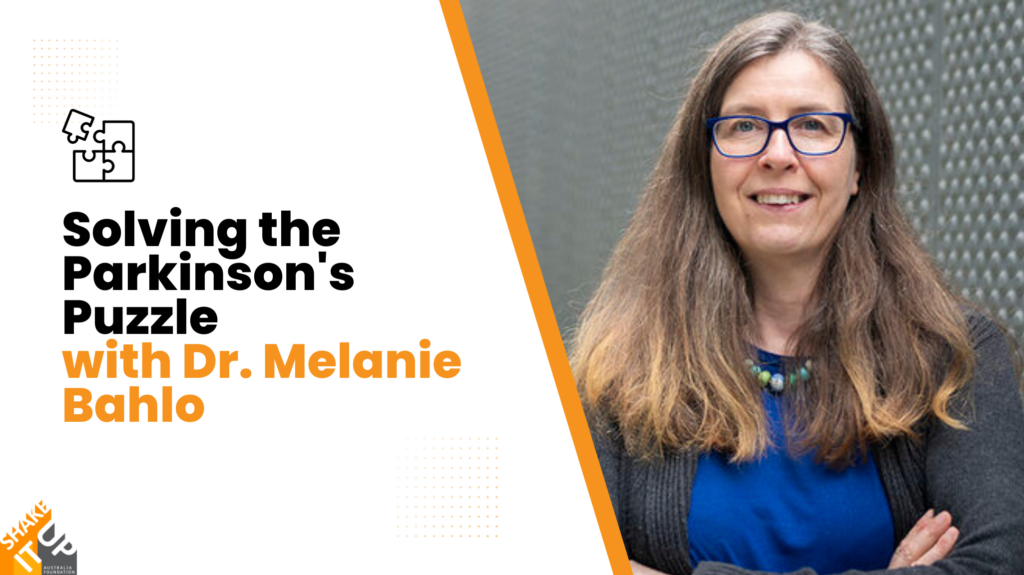
Over 200,000 Australians are currently living with Parkinson’s disease, with a further 38 diagnosed everyday. It’s the fastest growing neurological disorder in the world, and there is still no cure. In our ‘Solving the Parkinson’s Puzzle’ series, we are speaking to leading Australian researchers to find out how their work is helping to slow, stop and ultimately cure Parkinson’s disease.
In this chat with Professor Melanie Bahlo, we hear about her research into the role of repeat expansions and mitochondrial dysfunction in Parkinson’s disease. Dr. Bahlo’s research team have developed novel computational tools that enable them to discover genetic signals of PD in a person’s DNA.
In 2023, Professor Bahlo was appointed a Member of the Order of Australia (AM) for significant service to genetic and infectious disease research, and to public health.
“I think this award highlights the work I have done in translating discoveries into the clinic, through highly collaborative work with clinical colleagues, which is something I am very passionate about,” she said.
“It is important to do the research, but it is even more important that we use that research to translate our findings into treatments. It is an exciting time to be working in genetics and I think the next 10 years will see us make significant discoveries and deliver insights that will help us improve public health in Australia and across the world”
Melanie, can you tell us about your role and research focus?
I’m a Laboratory Head and Theme Leader at WEHI, and we are working on a project funded by Shake It Up Australia and MJFF, on the utilisation of something called mitochondrial copy number, and its role as a biomarker for Parkinson’s disease. The project also has a second aim, which is to look at a particular type of genetic mutation called ‘repeat expansions’ and its role in Parkinson’s disease.
How is your work helping to solve the Parkinson’s puzzle?
My work is concerned with analysis of data. So my lab runs something called a computational biology lab. Parkinson’s disease is a really complex disorder with a strong genetic component to it. And my work is about using very large data resources to try and tease apart the complexity in Parkinson’s disease. We know different patients with PD have different genetic risk factors and drivers. It’s important to tease those factors apart, because the therapies and treatments that need to be developed, are going to be targeted at particular genetic drivers.
In order to help people with PD, we really need to understand what’s driving the disease in each patient – and that’s what we’re trying to do in this project. We have some thoughts about what these drivers might be, and some measures by which we can detect particular people with Parkinson’s who are different. And if we can identify those people, we have a better chance of developing therapies at least for those subsets of people who carry those specific markers.
What’s the next phase of your research?
In science, it’s really important that your work is published and put out in the public domain – especially in front of other scientists, so they can evaluate your work and see that you’re on the right track. This is called peer review. We are currently writing up two pieces of work from our project, with initial results. So the work on the mitochondrial copy number, we see it has only limited potential because we figured out some things from the datasets we’re working on, which outline that it’s not going to have as much use as we thought. That’s ok! A negative finding is also important, so that other people don’t pursue that road.
The other interesting findings really do outline that there are a number of individuals who have been given a diagnosis of Parkinson’s, who may actually have similar diseases that aren’t PD but are driven by very, very clear genetic risk factors for diseases that have a lot of overlap in their symptoms. That is an important finding as work on some of those diseases has progressed further, and in a way is a simpler explanation or solution to the causes of PD in a small subset of PD patients.
What will your research mean for someone with Parkinson’s in 10 years’ time?
My research is concerned with genetic risk factors for Parkinson’s disease, which is a very complex and complicated neurological disorder. And it’s really important to identify what’s driving Parkinson’s disease in each individual PD patient, because the development of therapies will entail treatment for specific causes of the disease, rather than treatment for PD as a whole. So it’s really important to understand what’s causing it in each patient. Now, my work at the moment will only answer that for a small group of patients that have a specific genetic mutation that we are expert in identifying.
How has the funding from Shake It Up helped to make your research a reality?
This is my very first grant for my lab for my work in Parkinson’s disease! My work spans a lot of different diseases, so I was able to contribute my lab’s expertise to this Parkinson’s research effort through this very specific grant that we got, which was awarded for re-analysis of existing data. So without this grant, my lab would not be working on Parkinson’s disease, as they are now. So in effect, my lab has been recruited to the worldwide effort in PD through this funding.
Professor Melanie Bahlo AM from @WEHI_research says it's really important to identify what's driving #Parkinsons disease in each individual PD patient, to ensure more personalised therapies and treatments can be developed. Share on X

